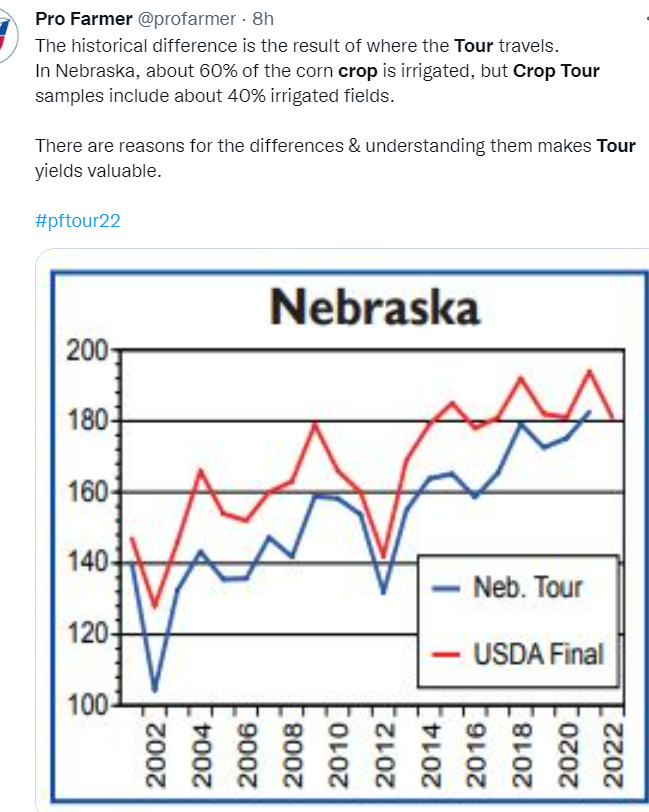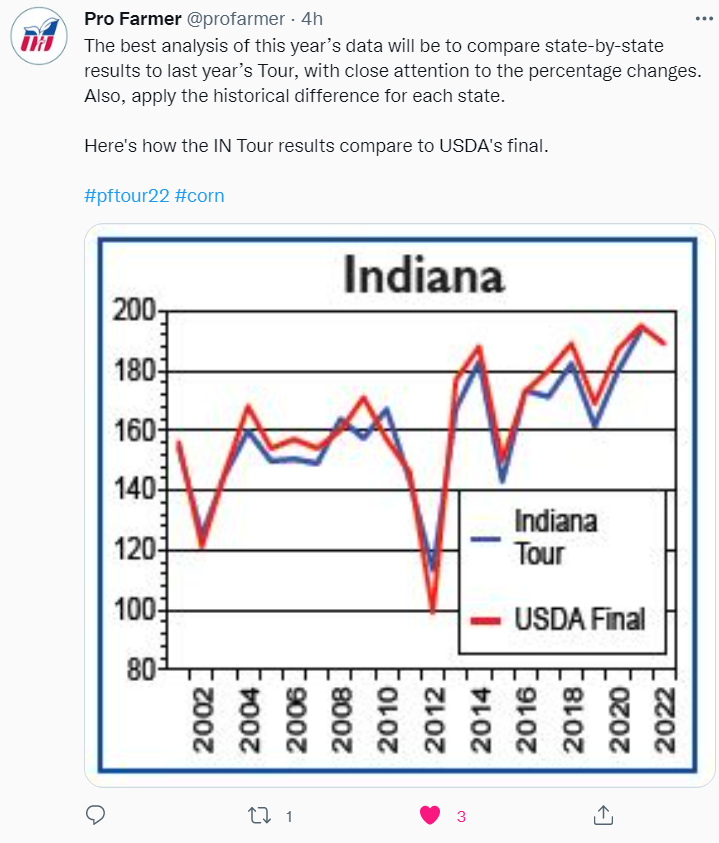From Clunker Crops to Bin Busters and Everything In Between

Evaluating dryland corn in Nebraska fields this morning was a déjà vu kind of experience for Brent Judisch.
“The dryland crop in Nebraska is similar to what I saw in South Dakota yesterday – pretty disappointing,” Judish told Tyne Morgan, host of U.S. Farm Report.
Here are the results from Day 1: Pro Farmer Crop Tour, Day 1: South Dakota Conditions 'Disappointing,' Grain Length Takes a Hit in Ohio
Morgan asked if crops and field conditions are as bad in Nebraska as what scouts on the Pro Farmer Crop Tour found during the 2012 drought.
@tyne_agtv Hail damage, heat stress, drought stress… we are seeing it all in Nebraska on #pftour22 #nebraska #corn #soybeans @ears_and_tassels ♬ Summer day - TimTaj
“Yes, they probably are,” said Judisch, who farms near Cedar Falls, Iowa. “I think the difference in 2012 is that we started that year off with moisture in the subsoil.
“This year, a lot of the areas we're going through have been dry a long time,” he said. “It’s a carryover dryness that started last fall and went through all winter, so there was no moisture reserve when spring arrived.”

East of Grand Island, in heavier, irrigated soils, he said yield estimates began to improve.
“We started off with a 150, then a 158 and we're just pulling 190 in this field,” Judisch said.
“That's been our best field so far today. These fields typically are yielding 230 to 240 bushels,” he added. “There are a lot of good farms with heavy dirt in this area, and there’s a lot of irrigation. So 230 to 240 bushels are kind of expected here.”
Some of the irrigated ground was hit by storms earlier in the summer that took out center pivots and turned irrigated corn into a dryland crop, said Chip Flory, AgriTalk Host and leader of the western leg of the tour.
“We’re seeing evidence of the hailstorms that went through – some irrigation systems are lying in the ditch – but I don’t see any fields that I believe were replanted,” he said.
By the time Flory had made five stops this morning, his team had reached irrigated corn crops that he expects will average in excess of 200 bushels per acre at harvest.
“We’re seeing another 10,000 ears per acre in irrigated fields than what we’re seeing in dryland corn,” he said.
Flory gave Nebraska irrigated soybean crops he evaluated this morning an above-average rating.
“The one problem is they’re dirty as heck,” he said. “There’s more volunteer corn in this bean crop than I can recall seeing in a long, long time.”
Flory believes what happened is farmers were able to get their first herbicide applications made in early spring, but then struggled because of poor weather conditions to get post treatments applied.
“I think what we’re seeing is the result of a second flush of weeds that farmers couldn’t get to,” he said.
Listen to Flory’s full morning report from Nebraska here:
On the eastern leg of the Pro Farmer Crop Tour, Indiana corn and soybeans show considerable variability, much like Ohio crops did yesterday, said Brian Grete, Pro Farmer Editor and tour leader.
"As we move into west-central Indiana, it’s notably drier. You can tell they’ve gotten some recent rains, which will help the soybeans more than corn,” Grete remarked after eight stops to evaluate crops this morning.

“We saw corn that will yield a low of 125 bushels and a high of 245 bushels,” he reported. “I’d says we’re looking at 180ish for an average in the state.”
@ears_and_tassels How to do a #pftour22 yield check on a very pitiful South Dakota corn field. @tyne_agtv #croptour #farm #farming #itsdryoutthere ♬ Poor, Poor Pitiful Me - Terri Clark
He attributes poor grain length and depth of fill, kernel abortion and uneven emergence as main contributors to the average to below average Indiana fields.
However, pod counts for soybeans look good, Grete noted.
“We had one clunker, but everything else I’ve seen is at least average,” he said. “I saw one field with a lot of waterhemp, but overall the soybean crop looks very solid.”
Hear Grete’s complete report on the Indiana crop here:
For exclusive access to professional grade news, analysis and advice, subscribe to Pro Farmer here.
Follow along with Crop Tour:
Understand the Pro Farmer Crop Tour Data-Gathering Process
Anticipation Is High Ahead Of Pro Farmer Crop Tour, Analysts Caution It Could Be A Big Market Mover
Here Are the Big Questions Analysts Want Answered on Pro Farmer Crop Tour







